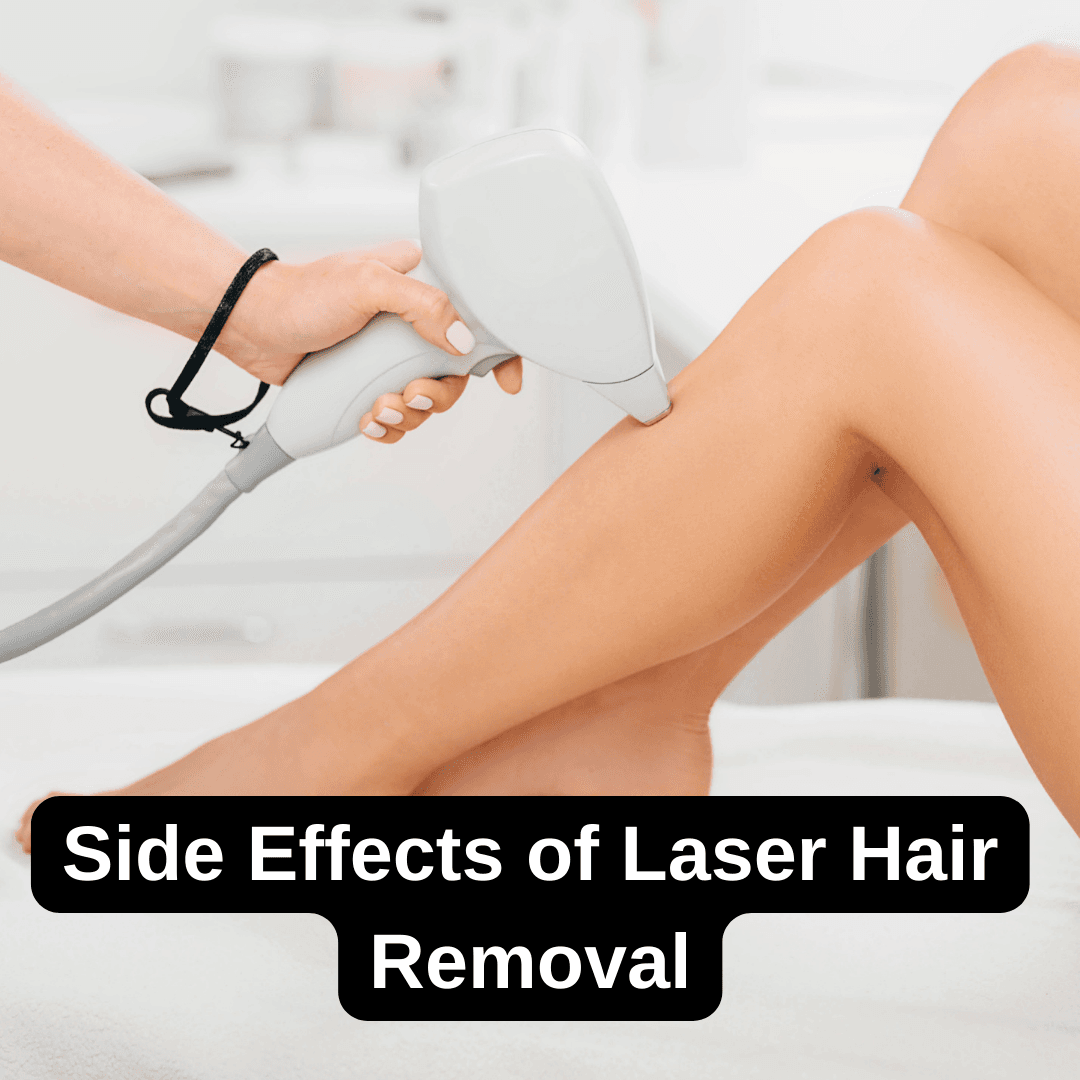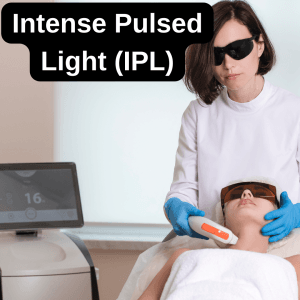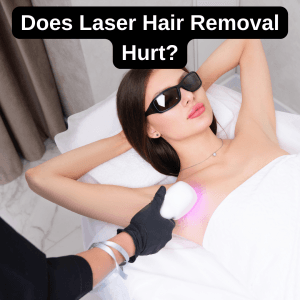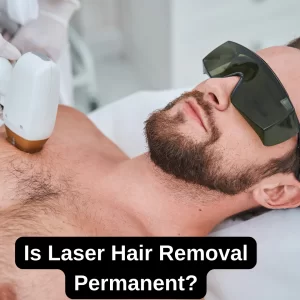Laser hair removal is a highly effective cosmetic treatment, widely chosen for its long-lasting results in reducing unwanted hair. However, as with all cosmetic procedures, understanding potential side effects—both common and rare—is crucial for achieving safe and satisfying outcomes. Although generally safe and FDA-approved, laser hair removal can cause temporary skin reactions or, in rare cases, more significant complications, especially if performed incorrectly or without proper aftercare.
This comprehensive guide thoroughly explores the possible side effects associated with laser hair removal, offers practical tips to prevent or manage these risks effectively, and clears up prevalent misconceptions about laser treatments, such as their alleged links to cancer or infertility. By learning what to expect before, during, and after laser hair removal, you’ll be empowered to make informed decisions and achieve optimal, risk-free results.
FDA Approval: Why Is It Important for Laser Hair Removal?
Laser hair removal treatments have been approved by the U.S. Food and Drug Administration (FDA) since 1997. FDA approval means the safety and effectiveness of laser hair removal devices have been thoroughly evaluated through clinical research. Treatments performed using FDA-approved devices by certified professionals significantly minimize any health risks, providing assurance that laser hair removal does not harm internal organs or overall bodily functions. Learn more about FDA medical device approvals.
To understand the difference between IPL and laser hair removal, check out our detailed guide on Intense Pulsed Light (IPL)
Common Side Effects of Laser Hair Removal
Temporary side effects from laser hair removal are usually mild, lasting from several hours to a few days. However, managing them correctly will significantly reduce discomfort and accelerate skin healing.
Redness and Skin Irritation
Redness, irritation, and slight swelling at the treatment site are the most frequently observed immediate reactions. The treated skin often resembles mild sunburn, which may feel warm to the touch and sensitive for a short period.
Cause:
This irritation occurs because laser hair removal uses targeted heat (photothermolysis) that penetrates the skin, destroying melanin-rich hair follicles. The surrounding skin, although minimally affected, can temporarily react by exhibiting inflammatory symptoms.
Typical Duration:
Redness typically peaks within the first 24 hours and subsides within 1–3 days.
Prevention and Management Tips:
- Immediately after treatment, apply a cold compress or ice pack wrapped in a clean cloth for 10–15 minutes at a time to soothe irritation.
- Aloe vera gel or a calming skin lotion containing chamomile or calendula can help reduce redness and enhance comfort.
- Avoid hot showers, baths, saunas, and exercise for at least 24 hours post-treatment to prevent increased inflammation.
Skin Pigmentation Changes
Temporary changes in skin color, known as hyperpigmentation (darkening) or hypopigmentation (lightening), can occur. Hyperpigmentation tends to happen more often in people with medium to dark skin tones, whereas hypopigmentation is somewhat rarer and more noticeable in darker complexions.
Cause:
Laser treatment targets melanin (pigment) in hair follicles, but sometimes surrounding skin cells also absorb some heat, altering pigmentation temporarily.
Typical Duration:
Pigmentation changes usually resolve naturally within several weeks to a few months, depending on individual skin healing capacity and aftercare diligence.
Prevention and Management Tips:
- Avoid direct sun exposure completely for at least two weeks pre- and post-treatment.
- Consistently use a broad-spectrum sunscreen (minimum SPF 30), reapplying every 2–3 hours when outdoors.
- Gentle exfoliation with recommended products after healing can encourage quicker recovery of natural skin tone, but always seek professional guidance before doing so.
Mild Crusting or Scabbing
Crusting or minor scabbing at the treated area occasionally appears a few days post-procedure. This effect is a sign of healing and typically resolves quickly without leaving permanent marks.
Cause:
Superficial skin damage or intense heat application during the laser procedure can trigger the skin’s natural protective response, leading to minor crust formation.
Typical Duration:
Crusting typically resolves within 3–7 days as skin heals and regenerates.
Prevention and Management Tips:
- Maintain regular moisturization using fragrance-free, hypoallergenic creams or ointments to soften and encourage healing.
- Avoid picking, scratching, or forcefully removing any crusting or scabs, as this can increase the risk of infection or scarring.
- Cleanse gently using mild, fragrance-free cleansers without rubbing the skin.
Mild Itching and Discomfort
Itching or mild discomfort can occur during the healing stage as treated skin regenerates. This sensation typically is mild, short-lived, and easily managed.
Cause:
Mild itching is a natural response as the skin heals and regenerates following laser-induced inflammation.
Typical Duration:
Usually resolves within 2–4 days, becoming progressively less intense.
Prevention and Management Tips:
- Apply soothing, anti-inflammatory creams like aloe vera gel, calendula-based lotions, or low-strength hydrocortisone creams if itching is persistent (after consultation with your provider).
- Wearing soft, breathable fabrics helps minimize irritation due to friction.
- Avoid using any skincare products containing alcohol, fragrances, or harsh chemicals until fully healed, to reduce potential itching or irritation.
By proactively managing these common side effects with recommended aftercare, you significantly improve your comfort, accelerate healing, and enhance the long-term success of your laser hair removal treatment.
Rare Side Effects of Laser Hair Removal
Though uncommon, serious complications may arise from laser hair removal if incorrect techniques or aftercare procedures are followed. Understanding these risks thoroughly will help you choose an experienced specialist and significantly reduce the chance of adverse reactions.
Burns and Blisters
Burns or blisters can occasionally result from improperly calibrated lasers, inexperienced technicians, or unsuitable equipment settings. Such injuries can range from mild superficial burns to deeper tissue damage.
Cause:
Burns occur when the laser energy settings are excessively high or incorrectly adjusted for your specific skin tone or hair type, leading to excessive heat absorption by the skin itself rather than just the hair follicle.
Signs to Watch For:
- Immediate and intense burning sensation during or after treatment
- Formation of painful blisters shortly after the procedure
- Persistent redness or swelling lasting more than a few days
Typical Duration:
Healing can take from a few days for mild burns to several weeks for more severe cases.
Prevention and Management Tips:
- Always choose a certified, licensed provider with extensive experience performing laser hair removal.
- Confirm the clinic uses FDA-approved laser devices specifically suitable for your skin type.
- Report any severe discomfort or burning immediately during treatment, allowing the technician to adjust laser settings promptly.
- For minor burns, keep the area clean, apply antiseptic creams prescribed by your provider, and avoid exposing the area to heat or sunlight.
Permanent Scarring
Though rare, permanent scarring can occur if post-treatment care is inadequate or if severe burns become infected.
Cause:
Persistent inflammation, infection, or improper healing of burn injuries significantly increases scarring risk.
Signs to Watch For:
- Skin that remains discolored or uneven weeks after treatment
- Formation of raised or depressed scars in previously treated areas
Typical Duration:
Scars, once formed, may be permanent without dermatological intervention.
Prevention and Management Tips:
- Strictly follow all aftercare guidelines given by your treatment provider.
- Avoid scratching, rubbing, or aggressively cleansing the treated area until completely healed.
- If scarring develops, consult a dermatologist immediately; early intervention with treatments like silicone gels or laser resurfacing can significantly reduce the visibility of scars.
Paradoxical Hypertrichosis
In rare cases, paradoxical hypertrichosis (an increase in hair growth) can occur in treated areas. This condition is most frequently observed in individuals with darker skin tones, hormonal imbalances, or when inappropriate laser settings are used.
Cause:
Incorrect laser parameters or inappropriate wavelength choices can stimulate hair follicles instead of destroying them, causing enhanced hair growth in some cases.
Signs to Watch For:
- New or denser hair growth occurring a few weeks after treatment
- Hair appearing thicker or more noticeable in treated regions
Typical Duration:
Without proper corrective treatment, the condition may persist or worsen over time.
Prevention and Management Tips:
- Prior to treatment, ensure the laser practitioner thoroughly evaluates your hair color, skin tone, and medical history to set appropriate laser parameters.
- If paradoxical hypertrichosis is suspected, discontinue further treatments immediately and consult a specialized dermatologist or laser treatment expert for corrective measures.
Skin Texture Changes
Alterations in skin texture, such as roughness, unevenness, or tiny indentations, may rarely occur. This issue typically arises from overly aggressive treatments or when performed on recently tanned or sun-exposed skin.
Cause:
Intense laser energy settings or recent tanning can disrupt normal skin regeneration processes.
Signs to Watch For:
- Persistent rough or bumpy skin after healing
- Development of noticeable uneven skin texture lasting several weeks or more
Typical Duration:
Texture changes may improve gradually over several months but sometimes require medical intervention.
Prevention and Management Tips:
- Completely avoid sun exposure and tanning beds at least two weeks before and after laser hair removal sessions.
- Inform your technician of any recent tanning or skincare procedures to adjust laser intensity accordingly.
- Gentle exfoliation and regular moisturizing (with dermatologist-approved products) can help restore smoother texture, but consult your provider before beginning any corrective skincare routine.
Infection and Herpes Outbreaks
Rarely, skin infections or activation of the herpes simplex virus can occur after laser hair removal treatment, particularly around the facial area or bikini line.
Cause:
Micro-injuries caused by laser treatment can expose skin to infection. For those with a history of herpes simplex, the laser’s thermal energy may reactivate the dormant virus.
Signs to Watch For:
- Increased redness, warmth, pain, swelling, or pus discharge signaling possible infection
- Painful blisters characteristic of a herpes outbreak occurring shortly after treatment
Typical Duration:
Symptoms of infections and herpes outbreaks typically resolve within 7–14 days with proper medical care.
Prevention and Management Tips:
- Clearly inform your laser technician of any history of cold sores or herpes prior to treatment. Your provider may prescribe antiviral medication preventively.
- Follow strict hygiene practices post-treatment, applying topical antibiotic ointments recommended by your specialist to minimize infection risk.
- Seek medical attention immediately if any signs of infection or herpes outbreak develop to ensure rapid resolution and prevent further complications.
Addressing these rare but possible complications by choosing an experienced specialist and rigorously following their aftercare instructions significantly minimizes risks, ensuring the safest and most effective results from your laser hair removal treatments.
Does Laser Hair Removal Damage Internal Organs?
Laser hair removal devices emit targeted beams that only penetrate a few millimeters into the skin, effectively destroying hair follicles without affecting deeper tissues. Internal organs are located much deeper beneath the skin, making it physically impossible for laser beams to reach or damage them. This is confirmed by numerous clinical studies and the FDA, ensuring the internal safety of this cosmetic procedure.
Debunking Common Laser Hair Removal Myths
Despite laser hair removal’s widespread popularity and safety record, misconceptions still exist. Clear, factual information helps dispel fears and ensures informed decision-making.
Many confuse laser hair removal with laser waxing, which operates differently. Learn more about these distinctions in our detailed comparison.
Can Laser Hair Removal Cause Cancer?
Myth: Some believe laser hair removal may increase cancer risk.
Fact: No scientific evidence supports a link between laser hair removal and cancer.
- Scientific Explanation:
Laser hair removal uses non-ionizing radiation, meaning it does not penetrate deeply enough to alter DNA or affect internal organs. The lasers specifically target hair follicles just beneath the skin surface, leaving surrounding tissue unharmed. - Supporting Evidence and Authority:
The Skin Cancer Foundation explicitly confirms that cosmetic lasers, including those used in hair removal, pose no cancer risk. In fact, certain laser types are medically employed to treat precancerous skin conditions, further emphasizing their safety profile.
According to a study published by Dermatology Times, laser treatments may even help prevent certain types of skin abnormalities.
The Cancer Council Australia also confirms that laser hair removal does not increase cancer risk, reinforcing the safety of these procedures.
Does Laser Hair Removal Affect Fertility?
Myth: Concerns exist that laser hair removal might negatively impact fertility or reproductive organs.
Fact: Laser hair removal does not affect fertility, reproductive organs, or overall reproductive health.
- Scientific Explanation:
The laser energy used in hair removal procedures penetrates merely a few millimeters into the skin, targeting only the hair follicle structures without reaching or influencing internal reproductive organs such as ovaries, uterus, or testes. Treatments in sensitive areas like the bikini line or abdomen have been demonstrated to be safe and have no effect on fertility or pregnancy outcomes. - Supporting Evidence:
Medical consensus from major dermatological and reproductive health associations uniformly indicates no correlation between superficial laser treatments and fertility issues.
Including these explicitly detailed myth-busting sections ensures readers fully understand the scientifically supported facts about laser hair removal, making your content authoritative, trustworthy, and superior to competitors who often gloss over these critical points.
Laser Hair Removal and Pregnancy: Is It Safe?
Current medical guidelines advise against laser hair removal during pregnancy, primarily due to safety concerns and limited scientific evidence. While no conclusive studies directly show harm to the fetus, dermatologists and obstetricians unanimously recommend postponing this procedure until after pregnancy and breastfeeding.
Reasons to Avoid Laser Hair Removal During Pregnancy
- Hormonal Changes Reduce Effectiveness:
During pregnancy, elevated hormone levels—particularly estrogen and progesterone—can dramatically alter hair growth patterns. Hair may become thicker, grow faster, or appear in new places like the abdomen or chest. Because laser hair removal targets actively growing hair follicles (anagen phase), fluctuating growth cycles during pregnancy make treatments less predictable and significantly less effective. - Increased Skin Sensitivity and Irritation Risk:
Pregnancy hormones can also lead to heightened skin sensitivity, increasing the likelihood of skin irritation, redness, or swelling after laser treatments. Pregnant individuals might experience more pronounced side effects, such as hyperpigmentation (skin darkening), hypopigmentation (skin lightening), itching, or even blistering, due to this increased sensitivity. - Lack of Definitive Research on Fetal Safety:
One of the main reasons health providers advise postponing laser hair removal during pregnancy is the lack of robust clinical research on potential fetal impacts. Although laser hair removal uses non-ionizing radiation—which penetrates only superficially into the skin and theoretically poses minimal risk—the absence of definitive studies means a cautious approach is safest.
Alternative Hair Removal Methods During Pregnancy
Since laser treatments aren’t recommended during pregnancy, consider safe and effective alternatives:
- Shaving: Safest method during pregnancy, with minimal risk of skin irritation when done gently.
- Waxing or Sugaring: Generally safe during pregnancy; however, increased sensitivity could lead to temporary discomfort or irritation.
- Depilatory Creams: Usually safe if labeled pregnancy-safe; always perform a patch test to prevent allergic reactions or irritation.
For those considering Brazilian laser hair removal, it’s best to wait until after pregnancy to ensure safety.
Expert Recommendation on Timing for Laser Hair Removal
Medical experts consistently recommend waiting until after childbirth and completion of breastfeeding before resuming or beginning laser hair removal treatments. Typically, waiting at least 6 to 12 weeks post-delivery allows hormone levels and skin sensitivity to return closer to pre-pregnancy states, increasing treatment efficacy and reducing risks.
Laser hair removal is not recommended during pregnancy due to hormonal changes affecting treatment effectiveness, increased risk of skin sensitivity, and the lack of conclusive safety data on fetal development. Medical professionals universally advise waiting until after pregnancy and breastfeeding are complete to ensure maximum safety and best results.
Who Should Avoid Laser Hair Removal?
While laser hair removal is generally safe and effective, certain health conditions and personal circumstances significantly increase the risk of complications. To prevent potential side effects or ineffective results, the following individuals should avoid laser hair removal treatments:
- Pregnant or Breastfeeding Women:
Pregnancy and breastfeeding cause hormonal fluctuations, making hair growth patterns unpredictable. Additionally, skin sensitivity increases, raising the risk of adverse reactions like hyperpigmentation, irritation, or burns. There is also limited research regarding potential effects on fetal and infant health, leading experts to recommend delaying laser treatments until after breastfeeding is completed. - Individuals with Active Skin Infections or Conditions:
People experiencing active skin conditions such as eczema, psoriasis flare-ups, dermatitis, fungal infections, or open wounds should postpone laser treatments. Laser exposure can exacerbate inflammation, prolong healing, and increase the risk of infections. - Individuals Prone to Keloid or Hypertrophic Scarring:
Those with a history of developing raised scars (keloids) or thickened hypertrophic scars should avoid laser hair removal. Even minor skin injuries or irritation from laser treatments could trigger abnormal scarring, leading to permanent cosmetic concerns. - Individuals Taking Photosensitizing Medications:
Certain medications, such as antibiotics (tetracycline, doxycycline), isotretinoin (Accutane), antidepressants, or herbal supplements like St. John’s Wort, can increase skin sensitivity to laser treatments. Using lasers while on these medications significantly raises the risk of burns, pigmentation issues, and severe irritation. It’s essential to consult your healthcare provider to determine safe timing after discontinuing these medications. - Recently Tanned Individuals (within 2 Weeks):
Individuals who recently used tanning beds, applied self-tanners, or had significant sun exposure should postpone laser hair removal. Tanned skin increases the likelihood of burns, uneven pigmentation, and decreased treatment effectiveness due to the laser’s targeting of melanin in the skin.
To ensure safety and effectiveness, avoid laser hair removal if pregnant or breastfeeding, experiencing active skin infections, prone to keloid scarring, taking photosensitizing medications, or recently tanned (within two weeks). Always consult a dermatologist or qualified professional before beginning laser hair removal to minimize risks and ensure optimal results.
For those considering alternative permanent hair removal options, explore how many sessions are required for electrolysis.
ractical Tips to Minimize Side Effects
To ensure the best results from laser hair removal and significantly minimize the risk of side effects, following specific pre- and post-treatment guidelines is essential. Clearly outlined, actionable advice enhances treatment effectiveness, promotes quicker recovery, and prevents complications—an aspect often overlooked by competitors.
Why Choosing a Reputable Clinic Matters
While laser hair removal is safe, potential risks arise mainly from treatments performed with unapproved devices or inexperienced practitioners. Choosing reputable clinics that use FDA-approved equipment and employ certified technicians greatly reduces risks such as skin irritation, burns, and scarring. Always research clinics thoroughly and confirm their certifications and device approvals before booking an appointment.
Pre-Treatment Advice: How to Prepare for Laser Hair Removal
- Avoid Sun Exposure and Tanning Beds:
Limit sun exposure and avoid tanning beds or self-tanning products for at least two weeks before your appointment. Tanned or sunburned skin increases the risk of burns, blistering, pigmentation changes, and reduces treatment efficacy. - Shave the Area 24-48 Hours Before Treatment:
Shaving shortly before treatment allows the laser to effectively target hair follicles beneath the skin surface. However, avoid shaving immediately before the session, as freshly shaved skin may be sensitive and prone to irritation. - Avoid Waxing, Plucking, and Hair Removal Creams:
Stop waxing, tweezing, threading, or using depilatory creams at least 4-6 weeks before your appointment. These methods remove hair from the root, preventing the laser from targeting active hair follicles effectively, thus compromising results. - Avoid Certain Medications and Products:
Discontinue photosensitizing medications or topical treatments like retinol, retinoids, alpha-hydroxy acids (AHAs), or benzoyl peroxide at least one week before your session. Always discuss medication usage with your dermatologist or provider before treatment.
Post-Treatment Care: Optimal Recovery and Skin Protection
- Soothe the Skin with Cooling Compresses or Gels:
Immediately after the session, apply ice packs, cold compresses, or aloe vera gel to reduce swelling, redness, and discomfort. Repeat as needed for the first 24-48 hours. Consider applying rose water to soothe and hydrate the skin post-treatment. - Use Sunscreen and Avoid Direct Sun Exposure:
Protect the treated area from direct sunlight with a broad-spectrum sunscreen (SPF 30 or higher) daily. Sun exposure post-treatment can cause hyperpigmentation, hypopigmentation, or other skin discoloration issues. Continue strict sun protection for at least two weeks post-treatment. - Skip Harsh Skincare Products and Exfoliants:
Avoid retinoids, glycolic acids, salicylic acid, and abrasive exfoliants for a minimum of 48 hours following treatment. These products can irritate already sensitive skin, delay healing, and increase the likelihood of side effects such as crusting or scabbing. - Avoid Hot Showers, Saunas, and Heavy Exercise for 24-48 Hours:
Refrain from activities that cause excessive sweating or heat exposure, such as hot showers, baths, saunas, steam rooms, intense workouts, or swimming in chlorinated pools, as they can irritate treated skin and prolong recovery.
To maintain healthy skin post-laser treatment, learn how often you should wash and exfoliate your face.
For optimal laser hair removal outcomes and minimal side effects, avoid sun exposure and hair removal methods like waxing and tweezing before treatment. Post-treatment, soothe skin with cooling gels, use sunscreen diligently, and temporarily avoid harsh skincare products, hot showers, and strenuous exercise. Always follow personalized instructions provided by your skincare professional to ensure safety and effectiveness.
For guidance on when and how to exfoliate after laser hair removal, read our comprehensive aftercare guide.
Comparing Hair Removal Methods
| Method | Duration of Results | Pain Level | Risks |
| Shaving | 1–3 days | Low | Minimal |
| Waxing | 3–6 weeks | Moderate | Ingrown hairs, irritation |
| Electrolysis | Permanent | High | Scarring, pain |
| Laser Hair Removal | Long-term reduction | Moderate | Minimal if done correctly |
If you’re considering alternative methods, explore whether waxing or using an epilator is better for long-term results.
Real-Life Experiences: What to Expect
Most patients describe laser hair removal as mildly uncomfortable, often likening the sensation to a rubber band snapping against the skin. Results typically become noticeable within two to three sessions. Patients emphasize that strictly following aftercare instructions significantly enhances results and prevents side effects. Results typically become noticeable within two to three sessions. For a detailed explanation of how long laser hair removal lasts, refer to our comprehensive guide.
Laser Hair Removal Statistics & Facts
- Over 90% of patients express high satisfaction with laser hair removal treatments (American Society for Dermatologic Surgery).
- Clinical studies indicate up to 90% hair reduction after completing recommended treatments.
- The global market for laser hair removal continues to grow at approximately 18% annually, reflecting its effectiveness and increasing popularity worldwide.
What Dermatologists Recommend: Expert Tips for Best Results
- Choose a licensed clinic with FDA-approved laser devices.
- Always disclose your medical history, including medication use, to your provider.
- Consistency matters; complete all recommended sessions (6-8 treatments).
- Adhere strictly to pre- and post-care instructions provided by your dermatologist to minimize risks.
When to See a Doctor After Laser Hair Removal
Always consult your doctor if you experience:
- Blistering or burns lasting more than a few days
- Significant skin discoloration not improving over several weeks
- Severe pain or swelling that doesn’t subside within 48 hours
- Symptoms indicating infection, such as increased warmth, redness, pus, or fever
Prompt medical attention ensures rapid resolution and prevents potential complications.
Popular Searches Related to Laser Hair Removal Side Effects
Laser hair removal bumps
Bumps after laser treatment usually resolve within a few days. Avoid picking, apply soothing aloe vera gel, and use a gentle moisturizer to accelerate healing.
Laser hair removal rash treatment
Use cold compresses and apply fragrance-free, calming lotions or hydrocortisone cream. If rash persists beyond a few days, consult your dermatologist.
How to treat laser hair removal burns
Treat mild burns with aloe vera gel or prescribed topical creams. Keep the area clean and avoid sun exposure. Seek medical help immediately for severe burns.
Hyperpigmentation after laser hair removal
Avoid sun exposure and consistently apply sunscreen (SPF 30+). Pigmentation usually resolves within weeks, but topical brightening creams prescribed by a dermatologist can speed recovery.
Does laser hair removal hurt?
Pain is generally mild to moderate, often described as snapping sensations. Topical anesthetics or cooling devices can significantly reduce discomfort.
Pain is generally mild to moderate, often described as snapping sensations. To learn more about the pain levels and discomfort associated with laser hair removal, visit our detailed guide.
Frequently Asked Questions about Laser Hair Removal Side Effects
Is laser hair removal safe long-term?
Yes, laser hair removal is safe for long-term use. Studies show no serious long-term side effects when performed correctly by licensed professionals.
Does laser hair removal cause permanent skin damage?
No, when done properly, laser hair removal doesn’t cause permanent skin damage. Temporary redness or mild pigmentation changes may occur, but severe or lasting damage is rare.
Can laser hair removal trigger acne breakouts?
Laser hair removal itself doesn’t cause acne. However, temporary irritation or improper aftercare can lead to mild breakouts. Following recommended skincare can easily prevent this.
Why is sun exposure dangerous after laser hair removal?
Sun exposure after laser hair removal can cause discoloration, burns, or prolonged irritation because treated skin is more sensitive to UV rays. Always apply sunscreen (SPF 30+) for two weeks post-treatment.
When should I seek medical help after laser hair removal?
Seek medical help immediately if you experience severe burns, blisters, persistent swelling, prolonged pain, signs of infection, or herpes outbreaks after treatment.
Long-Term Safety of Laser Hair Removal: What Studies Say
Clinical research conducted over the past two decades consistently demonstrates the long-term safety of laser hair removal. No credible scientific studies indicate any adverse health effects arising years after treatments. According to the FDA and various dermatological societies, properly conducted laser hair removal does not cause chronic health conditions, infertility, or other internal complications.
Medical Disclaimer
This article provides general information and is not a substitute for medical advice. Always consult a dermatologist or qualified medical professional for personalized care and treatment decisions.

Meet the Epilation World Expert Team
Our team consists of certified professionals with over 17 years of experience in laser hair removal, skincare, and personal care. With advanced training in diode laser, IPL, waxing, and skin health, we combine clinical precision with real-world expertise to deliver reliable, evidence-based guidance.
Every article is carefully created and reviewed by our experts to ensure safety, clarity, and scientific accuracy. Our work has helped thousands choose safe, effective hair removal solutions tailored to their unique needs.
Trusted expertise. Real results. That’s our promise.





